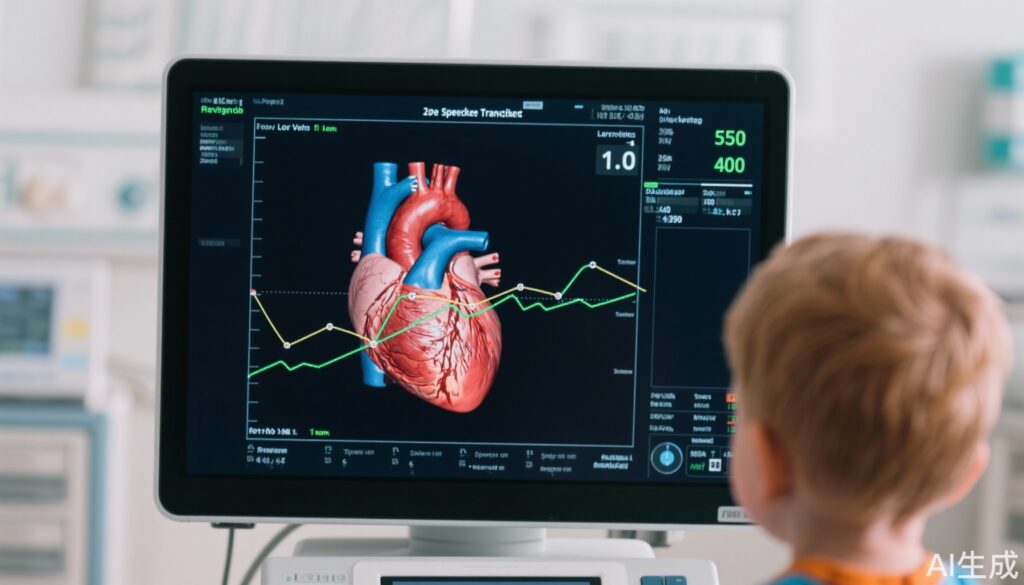Highlight
• Two-dimensional speckle tracking echocardiography detects subclinical ventricular dysfunction in nearly half of hospitalized MIS-C patients.
• Reduced LV longitudinal and circumferential strain parameters correlate strongly with adverse in-hospital cardiovascular outcomes.
• Most LV strain abnormalities peak around day 5 of illness and largely normalize within 50 days.
• Early assessment of LV strain may improve risk stratification and guide management in MIS-C.
Study Background and Disease Burden
Multisystem inflammatory syndrome in children (MIS-C) is a rare but severe post-infectious complication linked to SARS-CoV-2 infection. It presents with systemic inflammation and multi-organ involvement, frequently affecting the cardiovascular system. Cardiac manifestations include ventricular dysfunction, coronary abnormalities, arrhythmias, and shock. Conventional echocardiographic measures such as left ventricular ejection fraction (LVEF) can fail to detect subtle myocardial involvement, which may still confer high risk of adverse outcomes.
Two-dimensional (2D) speckle tracking echocardiography, a sensitive imaging technique measuring myocardial deformation (strain), detects early subclinical ventricular dysfunction before changes in ejection fraction occur. Yet, data on its application in MIS-C have been limited, and its prognostic value unclear. The MUSIC (Multicenter Outcome Study of Echocardiographic Strain in Children) Study was designed to address this gap by evaluating LV strain parameters in a large multicenter cohort of MIS-C patients and their relationship with clinical outcomes.
Study Design
The MUSIC Study was an ambi-directional cohort involving 32 centers across North America. It enrolled hospitalized MIS-C patients from March 2020 to November 2021 who met the case definition and had at least one echocardiogram centrally analyzed by a Core Laboratory. The echocardiographic assessment included 4-chamber LV longitudinal strain (4CH-LVLS), mid-ventricular LV circumferential strain (mid-LVCS), and early diastolic longitudinal strain rate (EDLSR).
Clinical data included demographics, biomarkers (troponin, C-reactive protein), LV volumes, and mass indexed for body size. The primary endpoint was a composite in-hospital adverse cardiovascular outcome comprising need for vasoactive support, arrhythmias, cardiac arrest, extracorporeal support, death, or heart transplant.
Statistical analysis utilized generalized estimating equation models to account for repeated measures and adjust for potential confounders, testing associations between strain parameters at admission and adverse outcomes.
Key Findings
The study included 349 MIS-C patients with a median age of 8.7 years (IQR 5.3-12.9). During hospitalization, 35% exhibited decreased LVEF, while 45% demonstrated depressed LV strain (4CH-LVLS and/or mid-LVCS). The worst strain values peaked around day 5 of illness. Importantly, half of patients with abnormal strain normalized within one week and 95% by 50 days, indicating mostly reversible myocardial involvement.
Adverse cardiovascular outcomes occurred in 35% of patients. These patients were significantly older and had higher admission troponin and C-reactive protein levels, increased LV end-diastolic volume and mass indexed to body size, and worse LVEF. Notably, their LV strain values were significantly more impaired:
- 4CH-LVLS: P=0.002
- Mid-LVCS: P=0.001
After adjusting for covariates, each unit worsening in strain measurements increased odds of adverse outcomes:
- 4CH-LVLS adjusted OR 1.09 (95% CI, 1.07–1.12)
- Mid-LVCS adjusted OR 1.06 (95% CI, 1.04–1.09)
- Worst LV strain Z score (combined 4CH-LVLS and mid-LVCS) adjusted OR 1.30 (95% CI, 1.21–1.41)
- EDLSR (early diastolic longitudinal strain rate) adjusted OR 1.68 (95% CI, 1.26–2.23)
These findings implicate LV strain measures as independent early markers of myocardial dysfunction and predictors of adverse cardiovascular events in MIS-C.
Expert Commentary
The MUSIC Study represents one of the largest multicenter efforts to characterize myocardial deformation in MIS-C using a standardized, core lab-driven 2D speckle tracking methodology. This consistency enhances the reliability and generalizability of results.
While conventional echocardiography remains invaluable, strain imaging provides incremental sensitivity to detect subtle myocardial inflammation and dysfunction that may guide tailored clinical management and follow-up intensity. The rapid normalization of strain abnormalities in most patients aligns with clinical observations of myocardial recovery after inflammatory insult.
Limitations include inherent variability in strain measurement techniques and the need for specialized software and expertise. Longitudinal follow-up beyond 50 days would be beneficial to assess for late sequelae. Integration with biomarkers, clinical parameters, and potentially cardiac MRI could further refine risk stratification and mechanistic understanding.
Conclusion
In hospitalized children with MIS-C, 2D speckle tracking echocardiography reveals that nearly half have impaired left ventricular strain indicative of subclinical myocardial dysfunction. Impairment in 4CH-LVLS, mid-LVCS, the worst combined strain score, and early diastolic longitudinal strain rate at admission independently predict in-hospital adverse cardiovascular outcomes, including shock and arrhythmias.
These findings highlight the role of strain imaging as a sensitive and prognostically valuable cardiac assessment tool in MIS-C, supporting its implementation for early risk stratification and management guidance. Further prospective studies are warranted to validate these results and explore long-term cardiac outcomes.
References
Sperotto F, Kazlova V, Trachtenberg FL, Truong DT, Aggarwal S, Block JR, Bradford T, Buddhe S, Dionne A, Dragulescu A, Farooqi K, Forsha DE, Giglia TM, Golding IF, Hasbani K, Jone PN, Krishnan A, Lang SM, McFarland C, Mitchell E, Moussi Saad E, Nowlen T, Pignatelli R, Pletzer S, Serrano R, Shakti D, Srivastava S, Thorsson T, Votava-Smith JK, Wilson H, Newburger JW, Friedman KG; MUSIC Study Investigators. 2D Speckle Tracking Strain Echocardiography in Multisystem Inflammatory Syndrome in Children: A Multicenter Analysis From the MUSIC Study. Circ Cardiovasc Imaging. 2025 Sep 3:e017620. doi: 10.1161/CIRCIMAGING.124.017620. Epub ahead of print. PMID: 40899279.



